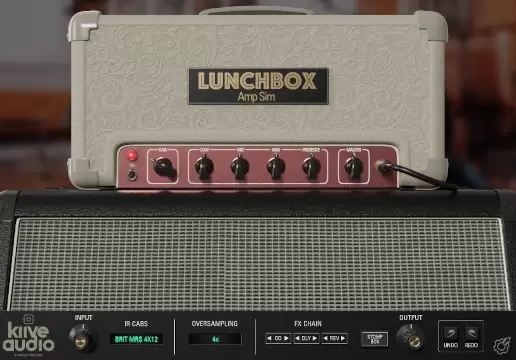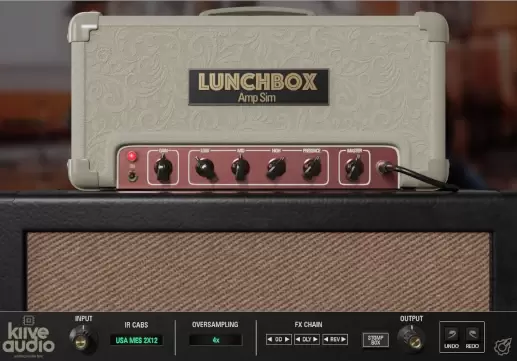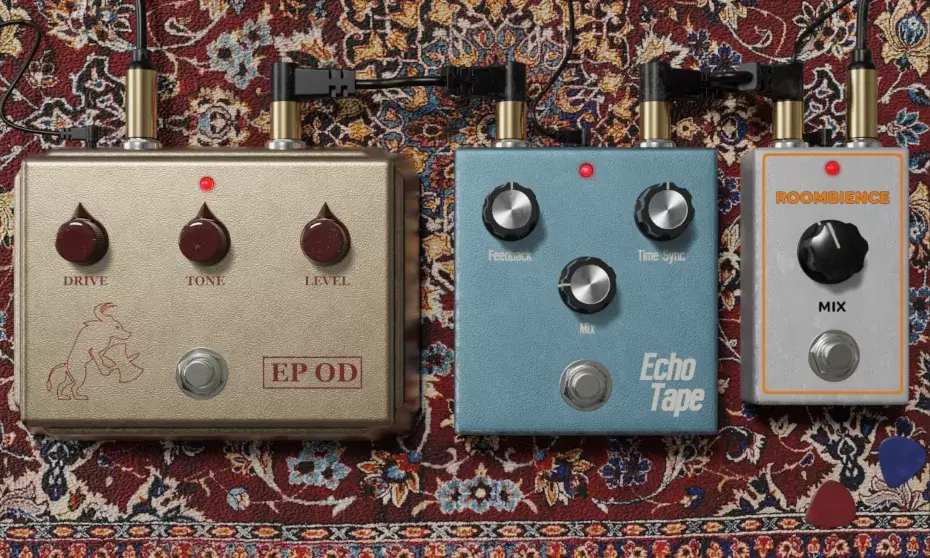Kiive Audio LunchBox Review (2023)
Kiive Audio is a new player on the digital field, coming to notoriety with the company's homerun smash, "Tape Face" - yet another take on the ever popular virtual Reel-to-Reel tape craze. The company is a small affair, comprised of Eddie Lucciola, Founder and Developer; and Pablo Ochoa, GUI Designer. Hailing from Canada myself, I can't help but hold a degree of pride in what this Canadian startup (Kiive Audio) has achieved since it began in 2020. Be that as it may, LunchBox can confidently step out on the world wide stage entirely on its own merits and impressive sonic properties. At the time of this publication, LunchBox may be had for only $36.40 -- a huge 47% savings off the normal MSRP (Manufacturer’s Suggested Retail Price) of $69.
Authorization and Activation
At A GlanceThis charming plugin is easy on the eyes and genuinely a pleasure to look at, greatly due to its clear layout and unpretentious presentation. Here we enjoy a mediumly subdued colour palette featuring a sand-taupe foundation augmented by an earthy, burnt orange-ish hued background, and muted, cranberry-like accents. The entire graphical design shows off tasteful, artfully-crafted 3D-esque protrusions, lighting effects and texturing. Overall, the plugin’s facade is of the photo-realistic variety, yet there is plenty of 3D-modelled styling to keep things visually interesting. LunchBox’s GUI has base dimensions of approximately 930px x 650px, but it can be downsized to 75%, or upscaled by as much as 150%, ensuring that it will accommodate HD screen resolutions with ease. For anyone using 4k resolutions (or higher), a higher resizing factor of 200% or greater would probably be even more advantageous.
The AppointmentsThere’s a capable 3-band parametric EQ on the amp’s faceplate, along with an oh-so-important active presence control. All of the tone controls default to 0dB at their straight up, 12 noon positions. Both ‘Low’ and ‘Mid’ range from -10dB to +10dB, but things begin to diverge a little hereon. The ‘High’ band sweeps from -10dB to +18dB, whilst the ‘Presence knob scales from -10dB to +8dB. There is a substantial 30dB of AMP input gain primed and raring to go. The ‘Gain’ knob can get snarly pretty fast – by the time you reach 10 o’clock, even a squeaky clean single coil signal starts to break up. Keeping the gain knob set to 9 o’clock or lower, and compensating with higher ‘Master’ volume settings, will produce lovely, clear tones reminiscent of typical clean VOX and clean Marshall-esque sounds. By the way, the Master volume provides a maximum of +12dB of "power amp" output. Down along the bottom of the GUI we’re accorded a tidy panel of simple controls to facilitate global plugin configuration. On each side you’ll find input and output dials – each of these can be set between -20dB to +20dB. You have a choice of three cabinet IRs onboard – these being a Marshall-like 4x12 selection, a decidedly VOX resemblant 4x12 cab, and a Mesa Boogie 2x12 offering. Alternatively, one can bypass the built-in IR engine entirely and enlist any other external IR loader such as Two Notes’ Torpedo Wall of Sound or Redwirez's MixIR. Oversampling options are conveniently available, variable from 2x up to a whopping 16x! From right here on the main screen you can enable or bypass each of the three included ‘stomp boxes’. To actually adjust the FX, simply click on the ‘Stomp Box’ button. This switches focus from the main amp view to a gorgeous, pedals-on-the-floor perspective. Herein we’re provisioned with a very basic pedal arrangement consisting of a Klon lookalike (overdrive), a Delay unit, and a Room reverb. I have to give full 100% marks and Top-of-the-Class Kudos to Pablo Ochoa (Kiive's graphics designer) for the superlative visuals. Why, you'd swear it was your Grandmom's dinning room carpet that you're looking at on the Stomp Box page!
How Does It Sound?To my ears, Kiive Audio has definitely hit a strong 3rd base run here. Eddie Lucciola has done a commendable job of creating a highly convincing VOX-meets-Marshall Plexi amp sim. LunchBox’s clean and low gain tones are indeed very reminiscent of the beloved chime-y liveliness that VOX valve amps from the early 60s had become so famous for. Conversely, there is more than enough snarly gain on tap to take any rocker well into grunge, hard rock, and even classic metal territories. This amp sim is a faithful nod to classic tube amps; it really isn’t intended to be a Triple Rectifier stand in, so it isn’t best suited to djent or modern metal. Tonally, there is a very wide sonic spectrum on offer here. Not only are the amp’s parametric EQ bands extremely variable, but the built-in cabinet IRs each contribute considerable tonality differentia as well. This amp sim has a genuineness about it that is gratifying, and it responds nicely to playing dynamics and pick attack. I especially like LunchBox for its edge-of-breakup, low gain and crunch tones - this is the sonic category in which it seems to excel. The upper mids and highs are generally pleasant without sounding unruly or rude -- unless you deliberately hype them. On the other hand, the low mids will turn tubby and overtly resonant quite easily if you aren't careful. The bass too, can get much too woolly and boomy if you don't scale the lows back by 3 to 6dB (possibly more depending on pickup type/position and IR selection). For this reason I don’t consider LunchBox to be well suited to modern metal or other musical genres where a tight, controlled high gain low end is absolutely necessary.
A couple of very convenient and helpful features that Igor Nembrini has slipstreamed into most nearly all of his Nembrini® amp sims, is built-in high and low pass filters, and a basic noise gate. Alas, these handy amenities are nowhere to be found in the LunchBox plugin, so here’s hoping that Kiive Audio will implement them in a future update (an update, not a v2 paid upgrade . . . ahem). Where this is a fairly straightforward amp sim, and since basic filters and noise gating are some of the less challenging DSP bits to code in, I really don’t consider this to be an unreasonable expectation. The onboard FX sound very good, if not limited in scope. I would like to see them be a bit more tweakable though. For instance, while the Echo pedal sounds lush and dimensional, it’s hard coded to be a ping-pong effect; it can’t be reconfigured to function as a simple (non ping pong) delay. Nevertheless, one of my favourite ways to exploit the Echo, is to dial in a short, slapback delay with a subtle wet mix of 12 to 15%. This trick results in a really wide, double-tracked type of sound that can indeed be very useful in many musical applications. The “Klon looking” overdrive does reproduce somewhat convincing Klon-ish properties across some of a typical electric guitar’s frequency range, but it isn’t as even-toned or well-balanced as an actual Klon pedal or Klon clone is (Eg. Rocket Archer or Wampler Tumnus). The overdrive is not as mid-bumped as an Ibanez Tube Screamer, but to my ears, it does suffer from a bit of raspy, nasal tonality. The EP OD cuts lows a bit more than the actual hardware would, but that’s not necessarily a bad thing, since this amp sim does have copious amounts of low end in reserve. I was really eager to try out the onboard ‘Klon’, but my hopeful excitement ebbed to moderate acceptance rather quickly. I’m not saying that the overdrive is bad – it’s actually quite decent. However, it is my considered opinion that if a developer is going to release a plugin that has a “Klon looking” component in the fray, they had better make double dog certain that their plugin accurately reproduces that famous, unmistakable Centaur tone. Jus’ Sayin’. The third onboard FX is the ‘Roombience’ reverb. It’s an acceptable room-meets-plate reverb effect – it isn’t bad, but neither will it WOW you. Used judiciously, Roombience will add some pleasant ambient space to your guitar signal, but you “get what you get” with it. There are zero parameters to tweak other its wet/dry mix, so if its long-ish decay and overall EQ curve doesn’t fit your project’s needs, you’ll not be able to modify it in any way. Generally, this amp sim does produce very cool, satisfying sonic flavours. Pumping a Les Paul through the BRIT MRS 4x12 cabinet IR using medium gain settings, dishes up some very sumptuous Marshall Plexi styled zest. I would prefer that its breadth of clean tones were a little more varied – it gets crunchy mighty fast. I appreciate the distinct properties of each of the three built-in cab IRs, but I am puzzled as to why Kiive Audio didn’t include an AC30 2x12 type of cabinet IR. Quite frankly, I would expect a VOX 2x12 configuration to be the default speaker choice in an amp sim of this type.
Concluding RemarksAll in all, what LunchBox has to offer is tasty, and makes for a great musical snack, but I honestly feel that there’s room for improvement. A few additional functionary appointments would take this plugin from merely being a good ‘snack pack lunch’ to being a solid, full portion meal. A quality SPRING reverb emulation, high and low pass filters, a noise gate, and an AC30 2x12 cabinet IR would round this plugin out perfectly. It also wouldn’t hurt to have more user control over the FX. For example, having configuration options available to change the Echo from being a stereo ping-pong to a straight ahead delay would be much appreciated; as would having control over the reverb’s decay time. Something that LunchBox has going for itself, in spades, is that it is extremely CPU and RAM friendly. Even when it’s set to 4x oversampling, LunchBox consumes less than 1% of my i7-10700 CPU (Reaper @44.1 kHz, 64 samples). Its memory requirements are nice n' light too. Even older i3 laptops shouldn't have any problem running a few simultaneous instances of this VST (or AAX). Here's a brief video to let you hear the different cabinet IRs and EQ range on a low gain setting. I used my 2016 Fender FSR Telecaster in the bridge position.
Stay in the Loop - Subscribe Today!Brother Charles is a freelance writer, Gospel music artist and minister. Charles had been a professional touring musician during the nineties; working primarily as a lead guitarist in the Canadian country music industry. Brother Charles is also involved with music production and quality home recording."
0 Comments
Your comment will be posted after it is approved.
Leave a Reply. |
NO SPAM! IK Multimedia Group Buy
FX Pick & Mix Group Buy - up to 16 for the price of 1
Will You Help?Web hosting is getting more and more expensive all the time, and Reviewer's Revival is NOT funded nor supported by any commercial enterprise or business. A donation of any amount is greatly appreciated. Even $2 or $3 for a coffee - every little bit helps. Thanks very much.
Legal BlurbAll of the articles published on Reviewer's Revival are undertaken to be purely objective, impartial reviews. Reviewer's Revival is not owned, funded-by, nor hired by any company or individual. Reviewer's Revival is the sole property of, and solely under the discretion and direction of Brother Charles. |



















 15% OFF Summer Sale!
15% OFF Summer Sale!
 RSS Feed
RSS Feed

